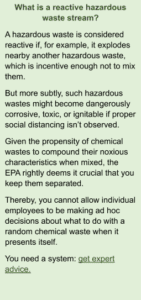How to consolidate your hazardous waste streams
February 11, 2021
It’s important to consolidate your hazardous waste streams. In EPA lingo, if your commercial or industrial enterprise generates only one kind of hazardous waste, which you can dump into a single tank, drum, or whatever, then you have a “single waste stream,” something that’s perilous enough to manage all by its lonesome.
But things get complicated and very expensive if you have what the EPA calls “multiple waste streams,” meaning that you’re generating two or more kinds of hazardous waste, each relatively benign in isolation, but reactive in combination, so they must be kept separated.
Bear in mind, if you have two, three, four hazardous waste streams, then your hazardous waste management costs will be commensurately double, triple, quadruple—economies of scale providing little solace to your CFO.
Obviously, the incentive here is to consolidate hazardous waste streams whenever you can, as the pecuniary benefits are manifest.
Streamlining Waste Management Through Combined Shipping Containers:
- Combining compatible waste materials into larger shipping containers reduces the number of units you need to ship, lowering your handling and transportation outlays.
- The fewer containers you handle & transport, the fewer need to be inspected, which lowers your compliance liability (should any fail to meet regulatory guidelines).
But consolidating waste streams is wrought with danger (see inset), making it extremely wise to get expert advice before you start mixing hazmat cocktails—whether shaken or stirred—and storing them onsite.
Just consider that ubiquitous and seemingly innocent component of both hazardous waste and baby food: H20 aka water.
Stirred up with sodium hydride or alkali metals (such as sodium or potassium), plain old water will generate flammable hydrogen gas. Or mix it with sodium phosphide, and expect highly toxic phosphine gas.
Another seemingly innocuous example: mixing an acid so mild that we sprinkle it on our salads—vinegar—with something as relatively benign as household bleach—Clorox®—will generate highly toxic chlorine gas.
So if you don’t have an in-house chemist on board—and maybe even if you do—prudence demands that you get expert advice. Also, consider:
- Acids in combination with cyanide salts or solutions will give off highly toxic hydrogen cyanide; and in the presence of sulfide salts or solutions, acids will yield similarly toxic hydrogen sulfide gas.
- Ammonia mixed with chlorine (again, simple household bleach) will generate chloramine vapor.
- Hydrogen peroxide might spontaneously detonate in the presence of sulfuric acid, ruining your whole day.
Two methods of consolidating waste streams by fuel blending
Obviously, you don’t want chemical reactions that are uncontrolled and unanticipated. However, the purposeful mixing of different waste streams to induce specific chemical reactions is a recognized treatment method for consolidating waste streams. There are two basic methods:
- Fuel blending—mixing waste streams to neutralize the hazardous waste material, rendering them less dangerous and thereby easier to store, transport, and ultimately dispose of.
- Incidental reduction—mixing waste streams with no intention of creating a specific chemical reaction, but the resulting hazmat no longer exhibits the same physical or chemical characteristics as did the individual wastes prior to being mixed.
Unfortunately, neither fuel blending nor incidental reduction is specifically defined in EPA rules. Requirements vary by state and localities. (In general, fuel blending requires a hazardous waste installation and operation permit for storage and treatment).
Summary
Consolidating waste streams as a part of your hazardous waste removal efforts can make sound economic sense. However, the legal and financial consequences of unplanned and uncontrolled chemical reactions demand expert advice and careful execution.
Also—issues of acute corrosivity, toxicity, ignitability, or explosivity aside—do it wrong and the applicable EPA, OSHA, and DOT fines & sanctions will dwarf any economies you were hoping to achieve
As we’re fond of saying: get expert advice before moving forward. And thank you for reading our blog!


